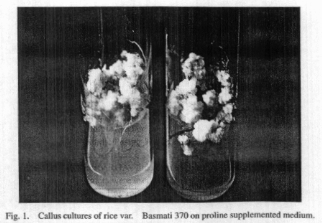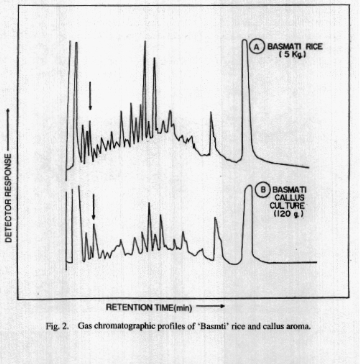|
24. Aroma synthesis in cell and callus cultures of rice
P. SUPRASANNA, T.R. GANAPATHI, N.K. RAMASWAMY, K.K. SURENDRANATHAN
and P.S. RAo
Nuclear Agriculture & Biotechnology Division, Bhabha
Atomic Research Centre, Trombay, Bombay 400
One of the emerging areas in plant biotechnology is the production
of value added compounds in cell and tissue cultures. The biotechnological
approach for flavour production offers advantages of non-dependency over
the environmental influence and creation of non-exhaustible source of homogenous
and well-defined products (Krings and Berger 1998).
Rice is a staple food for millions all over the world and
a considerable number of rice varieties are cultivated across different
regions. Among different rice varieties, Basmati rice is preferred for
its characteristic aroma and high export value in the international market.
Earlier studies have reported the characterization of aroma component of
Basmati rice to be 2-acetyl-1-pyroline (Buttery et al. 1983). In vitro
cultures offer a suitable system for the study of aroma synthesis. The
main objectives of our investigation were to study the production of Basmati
rice aroma in cell/callus cultures, and develop a system for continuous
aroma production. In this report, we present our results on the over-production
of aroma in Basmati rice callus cultures, characterization of its uniqueness
in comparison to aroma from seed samples of Basmati and immobilization
(encapsulation) of cell/callus cultures.
Callus cultures were established from mature seed explants
of rice cv. Basmati 370 on MS medium supplemented with 2,4-D (Fig. 1).
The callus was found to exhibit typical Basmati aroma and upon heating,
the same was found to be intense. Cell suspension cultures raised from
this callus also contained the same aroma. Several precursor-like compounds
or intermediates (such as L-proline, hydroxy-proline, acetyl CoA, sodium
acetate and pantothenic acid), possibly related to flavour production pathway
were tested, to see their effect on flavour production. Proline in the
medium was found to enhance the aroma as compared to control (untreated
Basmati callus) and other compounds, based on the organoleptic evaluation.
Treated and untreated samples as well as samples from a non-Basmati rice
variety were subjected to the evaluation in the heated and non-heated condition
and in both cases, treatments with L-proline followed by acetyl CoA had
a positive influence on aroma production.
Encapsulation of callus tissues was carried out with 3% sodium
alginate as per the procedure described earlier (Suprasanna eta!. 1996).
The encapsulated beads incubated in liquid MS basal mediul for 2-3 weeks
were found to possess the aroma in the medium.
The authenticity of the aroma components was confirmed by
determining the gas chromatographic profiles of the aroma concentrates
extracted from Basmati rice seed (5 Kg) and Basmati rice callus (120 gm).
Aroma concentrate from both had identical profiles (Fig. 2). The concentration
of the principal aroma constituents in callus subjected to over-production
process was at least 40-50 times more as compared to its concentration
in rice seed samples. The number of peaks and pattern were identical in
both cases confirming that addition of proline to the culture media resulted
in aroma production in cell suspension cultures and callus. Fractions separated
on silica gel were organoleptically evaluated for aroma and positive ones
were eluted from TLC plates. Efforts are being made to identify the individual
components responsible for aroma development in cell suspension and callus
cultures as well as to optimize methods for large scale cell cultures for
enhanced aroma production which can be used in the generation of aroma
principle.
|

